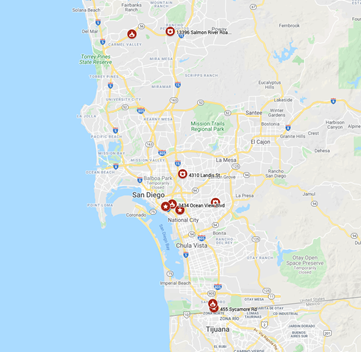Local sustainable power plant helping San Diego achieve its 100% renewable energy goals by 2035.
Case study – San Diego City
Cities are at the forefront of the national conversation about climate change. Increasingly, cities are looking for ways to deploy more clean energy to reduce their carbon footprints and increase overall savings.
Moving forward with microgrids:
City of San Diego will soon be operating eight micogrids, saving an estimated $6 million over 25 years in avoided energy costs. Construction is moving out of engineering into mobilization and is set to conclude in December 2022. San Diego is always looking for solutions to support its goal of 100% renewable energy by 2035.
This project was initiated and led by Gridscape in 2019 who worked with City of San Diego Sustainability Division, City Council members/staff, Mayor’s office, California Energy Commission (CEC), Groundworks San Diego-Chollas Creek, Shell New Energies, IBEW569, and Green Realities (EPC)
About the California Energy Commission:
CEC is the state’s primary energy policy and planning agency. Created by the Legislature in 1974; its responsibilities include forecasting energy needs, promoting energy efficiency, supporting the renewable energy market etc. Within the last two years, the most important development in California’s energy policy has been two landmark pieces of legislation for energy policy that focus on climate change and transportation.

Why microgrids make sense for cities?
Microgrids can provide several benefits to the environment, utility operators, and customers. These benefits are particularly important to cities, which strive to create safe, livable communities with thriving economies.
- Low carbon footprint: The global electricity demand will increase dramatically in the years to come (by 44% in 2030 in comparison with 2012 – IEA), cities need to provide access to energy but also keep the carbon footprint low.
- Aging grids and infrastructure- Climate change and natural disasters are putting a lot of pressure on the traditional grids thus we need local sustainable power plants to offset this pressure.
- Cities need to accommodate the massive pressure coming from EV.
- Apart from savings, microgrids provide Financial, Resilience, and Social Benefits.
- Green job creation, better quality of life.
Local sustainable power plant is the answer:
A microgrid is a self-contained power system that supplies electricity to a specific geographic area, such as a college campus, medical complex, shopping mall, or neighbourhood.
One or more types of distributed energy (solar panels, wind turbines, cogeneration, generators) are used to generate electricity within microgrids. Furthermore, many new microgrids have energy accumulators, which are often batteries. Electric vehicle charging stations are also available.
About Gridscape:
Gridscape is the largest and a well-established name specializing in developing and deploying standards-compliant future-proof products and solutions for renewable energy microgrids and fleet charging. Intended to serve as a locally produced sustainable power plant, these microgrids allow sites to become less reliant on the grid by using local sources of energy. They can provide as much as 90% independence from the grid energy, and thus reduce overall energy cost & provide backup clean emergency power during PSPS or other power disruption events. Gridscape with its ‘Product Centric’ approach to microgrids integrated with fleet EV charging solutions allows for lower cost of installation and reduces the time for deployment by substantially lowering integration issues. It expects to deploy and operate over 35 microgrids in California public and commercial facilities over the next 12 months.
Unlike traditional microgrid developers, Gridscape employs a holistic product-centric, artificial intelligence (AI) based software-driven approach to designing, deploying, and managing microgrids. It also integrates Electric Vehicle (EV) charging and other controllable loads into its solution. Through its broad partnerships with various Tier 1 and Tier 2 financiers, design engineering firms, energy storage manufacturers and other renewable energy product providers, it leverages the best-in-class mix of technology and finance to provide maximum return on investment to customers.
Gridscape’s solution is unique, and it differentiates from traditional systems in following manner.
Product Centric Approach (vs Project Centric Methodology) for scalability, maintainability, and longevity of microgrid assets
Software driven architecture resulting into no technology obsolescence and ability to adapt to changing PG&E tariffs and distribution grid conditions.
Dynamically configurable with an ability to change the microgrid operational modes on demand
Energy Information System: A cloud-based distributed energy resource management system (DERMS) that includes
1
Smart AI-based energy management and optimized load and generation dispatch; and
2
Very powerful visualization dashboard for accessing real time and historical data about PV, Storage and EV charging stations.
Inherently Integrated with EV charging infrastructure
Full Energy Management including demand charge reduction, TOU arbitrage, grid services.
Integration with various Cloud platforms such as Google, Amazon for grid services and load management.
Gridscape EnergyScopeTM Dashboards

The Project
Our project in San Diego is a prominent one and holds value in many ways.
The city expects to prioritize eight binding sites: three recreation centers, a fire, and three police stations. These eight microgrids will improve the city to decrease electricity use by 25% below 2010 levels by 2035. The solar emergency microgrids to be installed in the town are financed and owned by Shell New Energies. The result expecting from this project is a saving of energy cost approx. $420,854 annually.
The project consists of 960 kW of solar PV systems in various rooftop and carport configurations, 2175 kWh of battery energy storage systems and twelve EV charging stations.
1
The project will save approx. $420,854 in utility costs annually.
2
Year 1 (FY23) avoided energy costs (savings) are estimated at $57,000. The project is expected to generate cumulative 25-year avoided energy costs of $6,000,000
3
The project will also offset 2175 MT of GHG annually.
4
The project will reduce the peak demand and will contribute to additional cost savings.

Project Site Layout
Microgrid benefits for San Diego
- Community Benefit and Renewable Energy Equity: In this time and age, it is crucial to strengthen our green energy equity.
- Climate Action Plan and SB 100: Significant progress towards meeting the City’s Climate action plan and States GHG emission goal by 2045. The deployment will provide a roadmap to how San Diego could deploy a large number of microgrid in meeting its Climate Action goals and resiliency needs.
- City’s Leadership role in California: No other city in California has deployed 8 “small” microgrids across police stations, fire stations and community centers. Once the project is deployed, it will serve as a model for microgrid deployment across California. Microgrid deployments are key to California meeting its SB100 goals. It will also position City of San Diego favourably with CEC for future grants.
- Resiliency and Grid Stability: PSPS events and other power shut offs events create huge disruptions across San Diego and California. All these microgrids will provide backup power to the sites in case of a power shut off event due to wildfire, Earthquake and other unforeseen circumstances.
- EV Charging Infrastructure at each site, powered by clean renewable power, will pave-way for future electrification of the city fleet of emergency and maintenance vehicles.
Design
The project will be based on the system design and architecture with minor alterations as shown in following figure. As of now, the project is in design phase, and it will be ready for DSA review by the end of November 2021.

System Design & Architecture
The Sites
A.
Currently eight community solar microgrids are being designed deployed for the City of San Diego at the following sites.
- Dolores Magdaleno Memorial Recreation Center, 2902 Marcy Ave, San Diego, CA 92113 (District 8)
- Cesar Chavez Recreation Center/Larsen Field, 455 Sycamore Road, San Ysidro CA 92113 (District 8)
- Southcrest Recreation Center, 4149 Newton Ave, San Diego, CA 92113 ((District 9)
- Fire Station #19, 3434 Ocean View Blvd, San Diego, CA 92113 (District 9)
B.
Emergency (First Responder) Sites:
- Fire Station #29, 198 W San Ysidro Blvd, San Ysidro, CA 92173 (District 8)
- Police Station – Mid-City, 4310 Landis Street, San Diego, CA 92105 (District 9)
- Police Station – Southeastern Division, 7222 Skyline Drive, San Diego, CA 92114 (District 4)
- Police Station – Northeastern Division, 13396 Salmon River Road, San Diego, CA 92129 (District 5)
Project Financing
Four of the eight sites are disadvantaged communities (DAC sites). Financed by Shell New Energies, Gridscape is the project developer and OAM provider of the project with partial funding coming from California Energy Commission (CEC) under EPIC grant.
